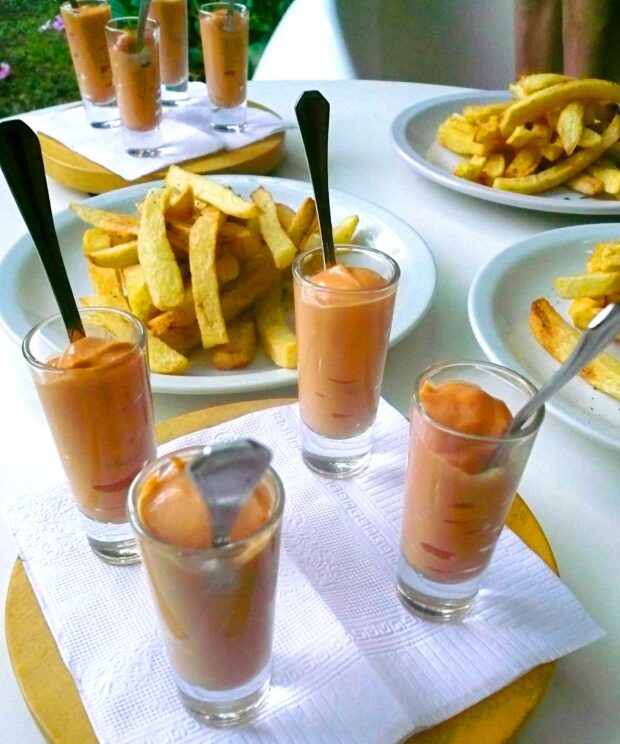Heinz‘s decision to release a new condiment called Mayochup, which combines ketchup and mayonnaise, ignited an unexpected debate on the internet. For years, both Utah and Puerto Rico have had their own official versions of a ketchup and mayonnaise combo. And they both think that they invented the sauce first. Passionate Puerto Ricans have argued that they’ve grown up with their beloved Mayo-Ketchup with hints of garlic. And Utahns can’t understand why anyone would try to hijack their insanely locally popular Fry Sauce. Fry Sauce vs Mayo-Ketchup: Which was first? Where does Salsa Golf fit into this debate? Is Heinz’s Mayochup just a ripping everyone off? And are we all just fighting about different names for a Thousand Island salad dressing?
Salsa Golf (1925)
According to Víctor Ducrot’s book, Los Sabores de la Patria, which means “The Flavors of the Country”, Nobel-prize winning biochemist, Luis Federico Leloir, invented Salsa Golf while on vacation near Buenos Aires. Leloir was eating at a golf club restaurant and asked his waiter for some mayonnaise alternatives. In parts of South and Latin America, mayonnaise is a popular shellfish dip (yuck). The waiter brought Leloir some side dishes with a variety of ingredients to try, including lemon, dill pickle juice, vinegar, ketchup, and mustard. What happens when you put a bunch of different ingredients in front of a chemist? You guessed it. Leloir mixed them together and invented Salsa Golf in 1925. Sorry Fry Sauce, Mayo Ketchup and Mayochup, Salsa Golf was the first pink condiment.
Fry Sauce (1941)
The history of Fry Sauce is well documented and even has its own Wikipedia page. It was invented in 1941 by Don Carlos Edwards, owner of the Arctic Circle fast-food restaurant chain. Fry Sauce is a proud part of the restaurant’s history.
Edwards’s new dipping sauce grew in popularity and the recipe for fry sauce quickly spread from Utah to the surrounding areas. For example, Utah’s state neighbor to the north, Idaho, happily adopted Fry Sauce. Idaho grows over 30% of America’s potatoes and is serious when it comes to french fries. Fry Sauce was the perfect condiment for their menus.

Today, most fast-food restaurants in the Mountain West Region that serve fries also serve Fry Sauce. The next time you are in the area, it won’t take long before Fry Sauce makes an appearance. As soon as you are around hamburgers, chicken fingers, onion rings or fries, someone will either ask you if you want Fry Sauce or just give it to you. It’s like a restaurant giving you a glass of water. Sometimes it just shows up at your table.
Mayo-Ketchup (1980s)
Unlike Fry Sauce, Puerto Rico’s Mayo-Ketchup isn’t as well documented. If you search Wikipedia for “Mayo-Ketchup”, it just redirects you to the Fry Sauce page. But from what we were able to discover, sometime in the 1980s, Goya released their Mayo-Ketchup product. Fry Sauce beat Mayo-Ketchup by about 60 years. From an ingredients’ perspective, Mayo-Ketchup is the least exciting of the bunch. Garlic powder is the only distinguishing ingredient in Mayo-Ketchup.
Wait, Isn’t It All Just Thousand Island Dressing Anyway?

Although Fry Sauce, Mayochup, Salsa Golf, and Mayo-Ketchup are all similar in color to a Thousand Island dressing, they are all uniquely different. Here’s a list of each condiment’s individual ingredients.
- Thousand Island Dressing: Starting with a base of mayonnaise and ketchup, Thousand Island Dressing also usually contains hints of Tabasco hot sauce, Worcestershire sauce, white vinegar, salt, garlic, minced pickles (or sweet pickle relish), onions, olives, and bell peppers.
- Salsa Golf: To help give it its unique Argentine flavor, Salsa Golf adds pimento, oregano, and cumin to the ketchup and mayonnaise mixed base.
- Fry Sauce: The original Arctic Circle fry sauce recipe includes sugar, salt, paprika, ground mustard, black pepper, and onion powder to spice up the mayonnaise and ketchup base.
- Mayo-Ketchup: The Mayo-Ketchup recipe is very easy. The main ingredients in Goya’s Mayo-Ketchup are mayonnaise, ketchup, and garlic powder.
- Mayochup: Heinz’s ingredients for Mayochup read more like a science experiment than a recipe: soybean oil, high fructose corn syrup, tomato concentrate from red ripe tomatoes, distilled white vinegar, enzyme-modified egg yolks, salt, sugar, onion powder, garlic powder, lemon juice concentrate, xanthan gum. Yuck! But Mayochup has one major advantage over the others: distribution. If you’re wondering where to buy Mayochup, just look in the condiment aisle of your local grocery store.
Fry Sauce vs Mayo-Ketchup
One thing that everyone can agree on, Heinz’s Mayochup hybrid condiment already exists. Heinz did not invent the idea forMayochup, they stole it. Seeing the popularity of the condiment in Puerto Rico, South America, and Utah, Heinz decided to bring Mayochup to masses. It makes a lot of sense for them as a company. Kraft Heinz sold close to $7 billion worth of sauces in 2016. And the more we all debate Fry Sauce vs Mayo-Ketchup, the more free publicity we create for Heinz.
What’s Your Favorite Ketchup And Mayo Condiment?
What’s the next condiment we should expect on grocery shelves, Mayostardayonnaise? Where do your taste buds stand? Are you behind Puerto Rico’s Mayo-Ketchup, Argentina’s Salsa Golf, Utah’s Fry Sauce, or Heinz’s Mayochup? Let us know in the comments.
Related Articles:
- What You Probably Didn’t Know About The Phrase “Couch Potato”
- Strange McDonald’s Menu Items From Around the World
- Woman Finds Fried Chicken Head in Her McDonald’s Order
- Michigan Teen Finds Human Finger in His Arby’s Sandwich
Urooj is a freelance writer of some repute, even if she says so herself. Her goal in life is to be published in every international magazine and visitor-load-weary website. She can be contacted at kaziurooj [at] gmail [dot] com.













 Are You A Member Of The Sleepless Elite, Or Just Sleep Deprived?
Are You A Member Of The Sleepless Elite, Or Just Sleep Deprived?
Leave a Reply
You must be logged in to post a comment.